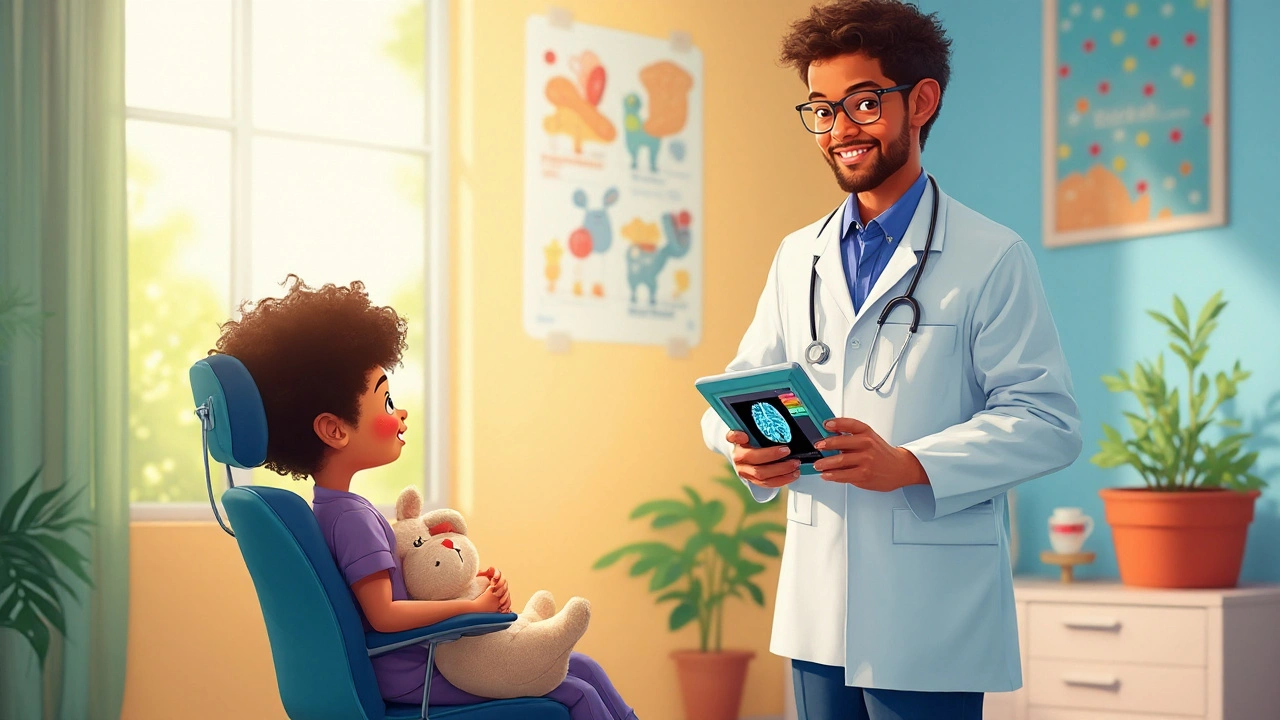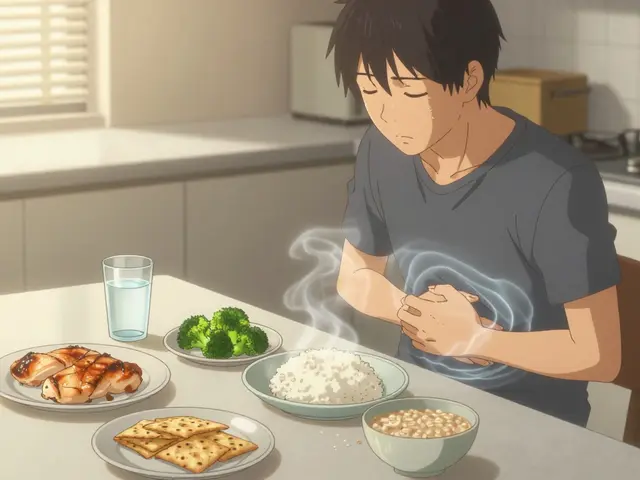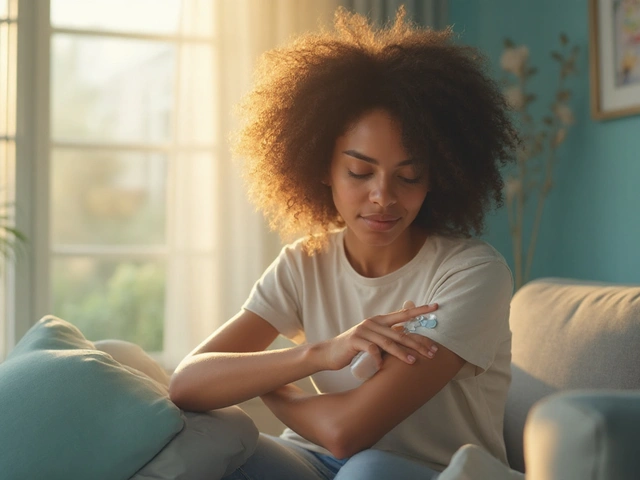Pediatric migraine is a neurological headache disorder that occurs in children and adolescents, characterized by throbbing pain, nausea, and sensitivity to light or sound. It differs from adult migraine in frequency, symptom presentation, and triggers, making early recognition crucial for effective care.
Quick Take
- Common signs: unilateral head pain, vomiting, visual aura, mood changes.
- Key triggers: missed meals, lack of sleep, bright lights, stress.
- First‑line treatment: age‑appropriate acute medication plus lifestyle tweaks.
- When to call a specialist: headaches > 3months, neurological deficits, or poor response to OTC meds.
Understanding Pediatric Migraine
Unlike the classic picture of a migraine‑suffering adult who can describe a "splitting" pain, children often use vague language like "my head hurts a lot" or "I feel dizzy". Migraine is a recurrent headache disorder involving neurovascular changes, cortical excitability, and neurotransmitter fluctuations. In kids, the disorder can manifest as short episodes (30minutes to a few hours) or prolonged attacks that disrupt school and play.
Research from the Royal College of Paediatrics shows that up to 10% of school‑age children experience migraine, with a peak incidence at 11‑13years. Girls are affected roughly twice as often as boys after puberty, likely due to hormonal influences.
Spotting the Signs
The hallmark symptoms can be grouped into three categories:
- Headache characteristics: Often unilateral, pulsating, worsens with activity.
- Associated features: Nausea, vomiting, photophobia (light sensitivity), phonophobia (sound sensitivity), and sometimes an Aura a reversible neurological phenomenon such as visual specks, zig‑zag lines, or tingling sensations.
- Behavioral clues: Irritability, withdrawing from play, refusing food, or sudden sleepiness.
Because children may not articulate these, parents and teachers should look for patterns - recurring absences from school, clutching the head after bright activities, or a sudden desire for a dark, quiet room.
Common Triggers
Identifying triggers is a game‑changer. Below are the most frequent culprits in children:
- Irregular meals or skipping breakfast - low blood‑glucose is a potent trigger.
- Sleep disturbances - both oversleeping and sleep deprivation can set off attacks.
- Bright or flickering lights - classroom projectors, video games, and even sunlight through windows.
- Stressful events - exams, family conflict, or changes in routine.
- Dietary items - excessive caffeine (in sodas or chocolate) and certain food additives like MSG.
Keeping a Headache diary a daily log where the child records headache timing, intensity, food intake, sleep, and activities helps pinpoint personal triggers.
Getting the Right Diagnosis
Diagnosis rests on clinical history and a focused examination. The International Classification of Headache Disorders (ICHD‑3) provides pediatric‑specific criteria, but a Pediatrician a primary‑care clinician trained in child health who can screen for red‑flag symptoms is usually the first point of contact.
Red‑flag signs that warrant urgent Neuroimaging brain scans such as MRI or CT to rule out structural causes include:
- Sudden onset of the worst headache ever (“thunderclap”).
- Neurological deficits - weakness, vision loss, or speech difficulty.
- Headache that worsens on lying down or is accompanied by fever.
If red‑flags are absent, the pediatrician may refer the child to a Neurologist a specialist in nervous system disorders who can confirm migraine and advise on preventative strategies.

Treatment Options
Treatment splits into two arms: acute relief for immediate attacks and preventive therapy for reducing frequency.
Acute Medications
First‑line agents are age‑appropriate doses of ibuprofen or acetaminophen. If pain persists after 2hours, a triptan (e.g., sumatriptan) may be prescribed for children over 12years.
Preventive Medications
Preventives are considered when children have >4headache days per month or when acute meds fail. Common choices include low‑dose amitriptyline, topiramate, and propranolol. Each comes with a distinct side‑effect profile, so shared decision‑making with the family is essential.
| Aspect | Acute Medication | Preventive Medication |
|---|---|---|
| Purpose | Stop a current headache | Reduce frequency/severity of future attacks |
| Typical Drugs | Ibuprofen, acetaminophen, triptans | Amitriptyline, topiramate, propranolol |
| Onset of Action | 30minutes - 2hours | Weeks to achieve full effect |
| Common Side‑effects | Stomach upset, rare rebound headache | Drowsiness, weight change, mood swings |
| Monitoring | Symptom relief, dosage adjustment | Regular follow‑up, blood work if needed |
Non‑Pharmacologic Measures
Medication alone rarely solves the problem. Integrating lifestyle approaches yields the best outcomes:
- Establish a regular sleep‑wake schedule - aim for 9‑11hours for school‑age kids.
- Promote balanced meals and hydration - avoid long fasting periods.
- Limit screen time and ensure breaks during bright activities.
- Teach relaxation techniques: breathing exercises, guided imagery, or gentle yoga.
When families adopt a Lifestyle management plan a structured set of daily habits targeting known migraine triggers, attack frequency often drops by 30‑50% within three months.
When to Seek Specialist Care
While many children respond to primary‑care management, certain scenarios demand a neurologist’s expertise:
- Headaches lasting longer than 72hours despite treatment.
- Progressive increase in frequency or severity.
- Co‑existing conditions like epilepsy, mood disorders, or chronic fatigue.
- Need for advanced therapies such as CGRP antibodies (currently approved for adolescents in some regions).
Early referral not only prevents chronic daily headache but also opens doors to multidisciplinary support - psychology, physiotherapy, and school‑based accommodations.
Putting It All Together - A Practical Checklist for Parents
Use this quick‐reference list to stay on top of your child's migraine journey:
- Start a headache diary today - note time, intensity (0‑10 scale), food, sleep, and activity.
- Identify at least two consistent triggers and work on modifying them.
- Discuss an acute medication plan with your pediatrician - dosage, timing, and when to switch.
- If attacks exceed 4per month, ask about a preventive medication trial.
- Schedule a follow‑up every 3months to reassess diary data and adjust treatment.
- Know the red‑flags that require urgent neuroimaging or specialist referral.
Following these steps can turn a chaotic migraine pattern into a manageable routine, letting kids enjoy school, sports, and family time without constant fear of the next attack.
Next Steps and Resources
For deeper dives, consider exploring these adjacent topics:
- Understanding Caffeine sensitivity how even small amounts of caffeine can provoke headaches in children.
- School‑based migraine accommodations - quiet rooms, flexible test timing.
- Emerging therapies: CGRP monoclonal antibodies for adolescents.
Remember, migraines are a medical condition, not a character flaw. With the right knowledge and a supportive team, you can help your child reclaim a pain‑free childhood.
Frequently Asked Questions
Can toddlers get migraines?
Yes. Even children as young as 2years can experience migraine‑type headaches, though they may express it as fussiness, crying, or clinginess. A careful headache diary and pediatric evaluation help differentiate migraine from other causes.
What’s the difference between a tension‑type headache and a migraine in kids?
Tension headaches are usually bilateral, steady, and not worsened by activity, while migraines tend to be unilateral, throbbing, and accompanied by nausea, photophobia, or aura. Migraine attacks often have a rapid onset and may be triggered by specific foods or sleep changes.
Are over‑the‑counter meds safe for children’s migraines?
Ibuprofen and acetaminophen, dosed by weight, are first‑line and generally safe. However, parents should avoid frequent use (more than 2‑3 days per week) to prevent medication‑overuse headache. Always follow the pediatrician’s dosing guidelines.
When should I consider a triptan for my child?
Triptans are approved for children 12years and older when standard analgesics fail. A neurologist can prescribe a weight‑based dose of sumatriptan or rizatriptan, usually after confirming the diagnosis and ruling out contraindications.
Can dietary changes really reduce migraine attacks?
Absolutely. Consistent meals, limiting caffeine, and identifying food triggers (like chocolate, cheese, or processed meats) can lower attack frequency by up to 30%. A food‑trigger diary paired with the headache diary sharpens the picture.
Is it normal for migraines to disappear during puberty?
Some children experience a reduction in attacks as hormonal patterns stabilize, but many continue into adulthood. Ongoing management and lifestyle habits remain important regardless of age.






Mike Privert
Great rundown on pediatric migraine. I’ve seen kids who can’t even label the pain, so the checklist is a lifesaver. Keeping a headache diary really helps spot patterns, especially around meals and sleep. Parents should also involve teachers so they can notice behavioral cues like sudden irritability. With the right acute meds and lifestyle tweaks, most attacks can be managed without specialist referral.
Veronica Lucia
Understanding that a child’s migraine may manifest as mood swings or a sudden need for darkness is crucial. It’s easy to dismiss these signs as a bad day when they’re actually neurologically driven. Empathy from caregivers creates a safe space for the child to share, even if it’s just "my head hurts a lot." The more we listen, the sooner we can intervene with both medical and non‑pharmacologic strategies.
Sriram Musk
The statistics you cited align with the Royal College study – roughly one in ten school‑age children experience migraines. Notably, the incidence peaks during early adolescence when hormonal changes amplify susceptibility. A systematic approach, beginning with a thorough clinical history, remains the gold standard before ordering any imaging. Moreover, documenting triggers such as irregular meals provides actionable data for clinicians.
allison hill
While the article emphasizes lifestyle changes, I can’t shake the feeling that pharmaceutical companies are pushing preventive meds too quickly. The side‑effect profiles of amitriptyline and topiramate are far from trivial, especially in a developing brain. Parents ought to be warned about potential mood swings and weight changes before committing to a long‑term regimen. And let’s not ignore the possibility of medication‑overuse headaches if OTCs are taken too frequently.
Tushar Agarwal
Just a quick tip – a simple spreadsheet can double as a headache diary and is easy for kids to fill out. Include columns for food, sleep, and screen time, and you’ll spot the culprits faster than you think 😊. Consistency is key, and the visual patterns often surprise both parents and doctors.
Richard Leonhardt
Here’s a condensed version of the checklist for busy parents: 1) Start a headache diary today. 2) Identify at least two consistent triggers – could be skipping breakfast or late‑night screen time. 3) Discuss acute meds dosing with your pediatrician and know when to switch. 4) If attacks exceed four per month, ask about a preventive trial. 5) Schedule a 3‑month follow‑up to reassess. 6) Memorize red‑flags like thunderclap headaches or neurological deficits. Following these steps can turn chaos into control.
Shaun Brown
When it comes to pediatric migraine, the first thing many clinicians overlook is the sheer complexity of the condition’s presentation in children. Unlike adults, kids often lack the vocabulary to describe a "throbbing" or "pulsating" sensation; they might simply say they feel "dizzy" or "like their head hurts a lot." This linguistic gap can lead to under‑diagnosis and, consequently, inadequate treatment. Moreover, the comorbidity profile is surprisingly diverse – anxiety, depression, and even sleep‑disordered breathing frequently co‑occur, muddying the clinical picture further. The literature suggests that up to 15 % of adolescents with migraine also meet criteria for a mood disorder, which in turn can amplify headache frequency and severity. Therefore, a multidisciplinary approach that includes mental health evaluation is not optional but essential. Lifestyle modifications, while beneficial, often face adherence challenges; children are naturally resistant to abrupt changes in screen time or diet, especially when peer pressure is involved. A pragmatic strategy is to implement incremental adjustments – for example, reducing caffeine by 25 % each week rather than eliminating it outright. In terms of pharmacology, the evidence base for triptans in the pediatric population is still evolving. While sumatriptan has shown efficacy in controlled trials for those over 12, we lack robust data for younger cohorts, making off‑label use a contentious topic. Similarly, preventive agents like propranolol and amitriptyline carry side‑effect burdens that can impact growth and academic performance, necessitating vigilant monitoring. One must also consider the psychosocial impact of frequent medical appointments; school absenteeism can compound academic difficulties and strain family dynamics. Engaging school personnel early – through individualized education plans or accommodations – can mitigate these downstream effects. Finally, the role of emerging therapies, such as CGRP monoclonal antibodies, is promising but currently limited by regulatory approvals and cost considerations. In sum, pediatric migraine demands a nuanced, patient‑centered plan that balances medical, behavioral, and environmental interventions, all while maintaining open communication with the child, parents, and educators.
Damon Dewey
Avoid overusing ibuprofen; it's a trap.
Dan Barreto da Silva
Whoa, Shaun, you just turned a medical summary into a novel! I love the drama but remember real families need quick, actionable tips, not a saga. Maybe a TL;DR at the top would help the overwhelmed parent scrolling at 2 am.
Ariel Munoz
Let’s be honest – the U.S. health system should prioritize migraine research more than it does. Our kids deserve world‑class care without having to wait months for a specialist. It’s about time we fund pediatric neurology adequately and stop relying on pricey adult meds for children.
Ryan Hlavaty
It is morally unacceptable to dismiss a child's pain as "just a headache." Every child has a right to proper diagnosis and treatment, and parents have an obligation to seek help early. Ignoring red‑flags not only jeopardizes health but also teaches a dangerous lesson about neglect.
Chris Faber
Thanks for the thorough guide – super helpful! I’ll share this with the PTA so we can create a quiet room at school. Kids need a safe space when a migraine hits, and teachers should know the signs.
aura green
Wow, this article really hits all the *right* notes – if you’re into the whole "let’s give kids a lifeline" vibe, you’re in for a treat! 😏 First off, I love the emphasis on diaries; nothing says "I’ve got my life together" like a spreadsheet full of snack times and headache scores. Then there’s the whole "don’t over‑medicate" mantra – because who doesn’t love a good reminder that popping pills like candy is a no‑go? The lifestyle tips are pure gold: consistent sleep, balanced meals, and limiting screen time – basically the holy trinity of parenting any modern kid. And let’s not forget the red‑flag list – because when your child starts acting like a drama queen, you’ll want to know if it’s actually something serious. All in all, this is the kind of guide that makes you feel both empowered and mildly terrified about the sheer amount of stuff you need to manage. Keep the good stuff coming, and maybe throw in a quick‑reference chart for the busy parents who can’t read full paragraphs at 2 am!
Edward Morrow
Alright, let’s cut the crap – migraines in kids are a nightmare, but the meds aren’t magic beans either. Ibuprofen works, sure, but if you’re chasing after a “miracle cure,” you’ll end up with a stack of pills and a kid who’s worse off. The real win is building a routine: no skipping breakfast, lights dimmed, screens off. If you think you can dodge the whole thing with a single prescription, you’re dreaming. Keep it simple, keep it real.
Shayne Tremblay
Parents, you’ve got this! Start with small wins: a consistent bedtime for a week, then tackle breakfast. Celebrate each improvement – even if it’s just a shorter headache episode. Your kid’s future self will thank you for the effort you put in today.